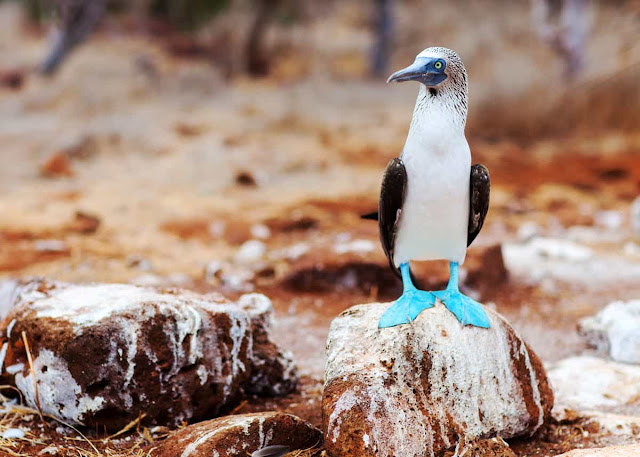Range and Habitat
Blue-footed boobies occur along the western coasts of Central and South America, sometimes as far north as California and as far south as Peru. Half of all breeding pairs live in the Galapagos Islands. They come to land only to nest, preferably on lava rock.
Diet
The blue-footed booby plunges head first into the ocean with
its wings partly folded to catch fish. It even catches flying fish when they
are still in the air. It can also dive for fish while it is in a swimming
position.
Difference between male and female
There are several clues that will allow us to identify male
and female blue footed boobies. The first thing we can see is that the male is
usually smaller than the female. They can also be identified by the sounds they
make (especially during the mating ritual) the male makes hissing sounds.
They can also be identified by the color of the head and the size of the pupils. White-headed boobies are usually male, and those with dark heads are female. In the same way (although it is a bit more complicated to observe) those with a large pupil are female and those with a small pupil are males.
Breeding and Reproduction
When performing a courtship display, boobies pick up their
feet and strut in a slow, dignified manner. They also bow, spread their wings
and point their wings and neck toward the sky, with their necks, heads and
bills stretched upward. These antics, along with mating and nesting occur
year-round.
Females begin breeding between one to six years of age,
while males begin between two and six years. Nesting consists of scraping the
ground, literally, and laying a ring of guano around the perimeter. They nest
at night in colonies and search for food during the day. The brood may consist
of up three chicks. The adults both care for them and use their large feet to
cover the chicks and keep them warm. Chicks are covered with a white, fluffy
down coat that can make them appear larger than their parents. In a good year,
all three of the young will survive; otherwise, the strongest one or two will
outlive the weakest, which subsequently dies of starvation.
Interesting Facts
👉THEIR FEET TURN BLUE WHEN THEY ARE MATURE
Blue-footed boobies aren’t born with blue feet! And unlike
marine iguanas, which may get their color from what they eat – the blue-footed
booby bird does not eat blue food to get their foot color…although diet does
play a partial role! Once a blue-footed booby is old enough, their feet with
begin to turn blue. It is one easy way to tell the difference between mature
and immature boobies. The same goes for the red-footed booby birds!
👉FEMALE BOOBY BIRDS HAVE BLUER FEET
Not all booby feet are created equal. Once mature, females
tend to have deeper blue hued feet than males! While not always easy to notice,
if you see a group of boobies together, try to compare their feet and see which
ones have bluer feet!
👉ONCE A PAIR OF BLUE-FOOTED BOOBIES IS TOGETHER, THEY DO A
COURTSHIP DANCE
Perhaps one of their most interesting characteristics is how
blue-footed booby couples will do a dance, in unison, by walking side-by-side
and lifting their feet in unison. It’s an exaggerated looking walk, and quite
comical if you’re lucky enough to see it!
Share with Your Friends..
Reference
https://galapagoslowcost.com/en/blue-footed-boobies-galapagos/
https://www.nathab.com/know-before-you-go/galapagos-islands/wildlife-guide/birds/blue-footed-booby/
https://www.galakiwi.com/blog/7-cool-things-about-the-blue-footed-booby-galapagos-animal-facts/
















No comments:
Post a Comment